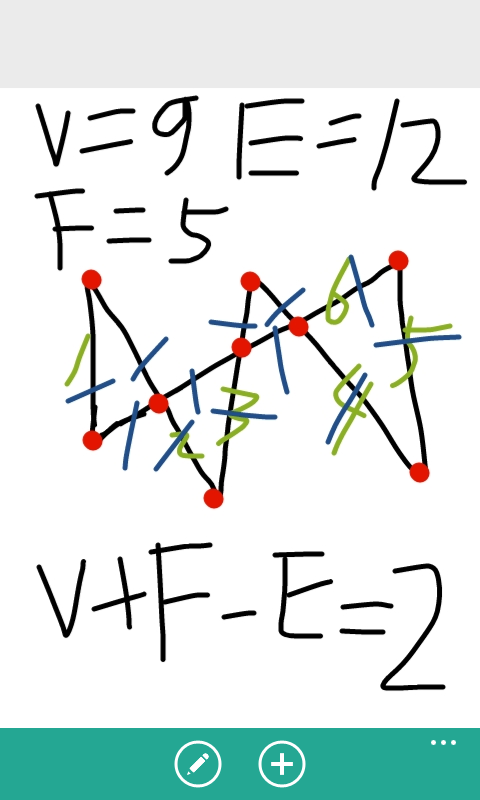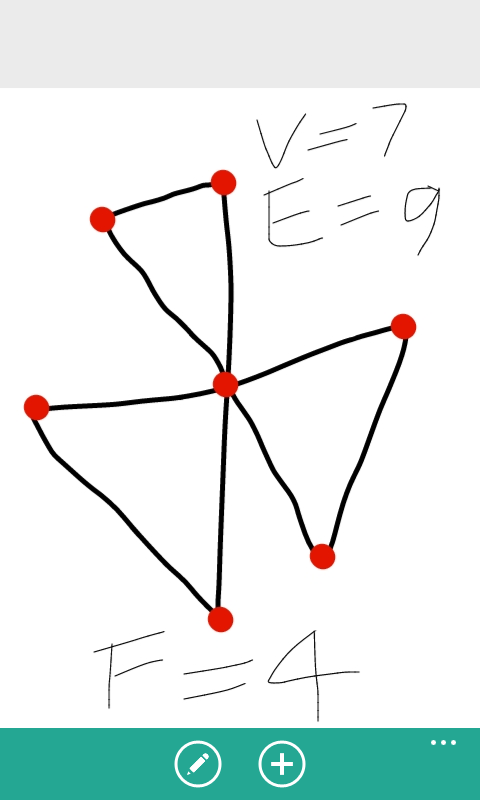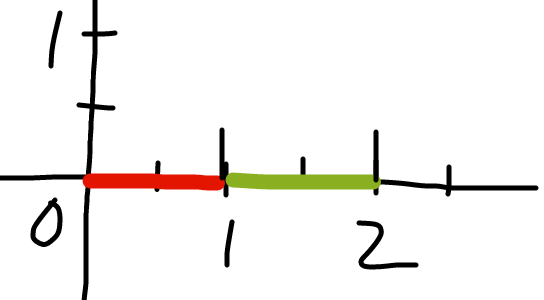poj2284 欧拉公式
题意:给出一图形,求该图形把平面分成了几部分
欧拉公式: http://blog.csdn.net/wangxiaojun911/article/details/4586550
对于二维平面上的情况。设图形上有V个点,E条边,把平面分成了F个独立的部分,那么满足V+F-E=2
如下图:


那么求F就转化成了如何求V和E
求V:枚举任意两线段的交点即可。注意可能出现三线共点的情况,要判重。
求E:某线段上的n个点会把这条线段分成n-1部分。用这个性质再YY一下就好了。
注意:
1.这里判重不能用map,因为交点的计算结果肯定是有精度误差的,再hash一下就没法判重了。
我用的方法是手艹了一个破vector,实际上有更简洁的方法.....
先排序,使重复的元素在数组里相邻。再用STL里的unique即可轻松实现去重
( Reference:http://blog.sina.com.cn/s/blog_a389f34a01013itn.html)
2.模板里的求两线段交点代码没有考虑这种情况:

如图,两线段分别为【(0,0)->(0,1)】和【(0,1)->(0,2)】
模板代码认为他们是不香蕉的= = 哼
所以这里要处理一下:
(大白书上lrj模板也存在这个问题)
//求两线交点
point crosspoint(line v)
{
if ((point_cmp(a,v.a))||(point_cmp(a,v.b))) return a;
if ((point_cmp(b,v.a))||(point_cmp(b,v.b))) return b; //处理端点处相交的情况
double a1=v.b.sub(v.a).det(a.sub(v.a));
double a2=v.b.sub(v.a).det(b.sub(v.a));
return point((a.x*a2-b.x*a1)/(a2-a1),(a.y*a2-b.y*a1)/(a2-a1));
}
AC Code:
#include<vector>
#include<list>
#include<map>
#include<set>
#include<deque>
#include<queue>
#include<stack>
#include<bitset>
#include<algorithm>
#include<functional>
#include<numeric>
#include<utility>
#include<iostream>
#include<sstream>
#include<iomanip>
#include<cstdio>
#include<cmath>
#include<cstdlib>
#include<cctype>
#include<string>
#include<cstring>
#include<cstdio>
#include<cmath>
#include<cstdlib>
#include<ctime>
#include<climits>
#include<complex>
#define mp make_pair
#define pb push_back
using namespace std;
const double eps=1e-;//精度
const double pi=acos(-1.0);//π
const double inf=1e20;//无穷大
const int maxp=;//最大点数
/*
判断d是否在精度内等于0
*/
int dblcmp(double d)
{
if (fabs(d)<eps)return ;
return d>eps?:-;
} bool dcmp(double x)
{
return (fabs(x)<eps);
} /*
求x的平方
*/
inline double sqr(double x){return x*x;}
/*
点/向量
*/
struct point
{
double x,y;
point(){}
point(double _x,double _y):x(_x),y(_y){};
//读入一个点
void input()
{
scanf("%lf%lf",&x,&y);
}
//输出一个点
void output()
{
printf("%.2f %.2f\n",x,y);
}
//判断两点是否相等
bool operator==(point a)const
{
return dblcmp(a.x-x)==&&dblcmp(a.y-y)==;
}
//判断两点大小
bool operator<(point a)const
{
return dblcmp(a.x-x)==?dblcmp(y-a.y)<:x<a.x;
}
//点到源点的距离/向量的长度
double len()
{
return hypot(x,y);
}
//点到源点距离的平方
double len2()
{
return x*x+y*y;
}
//两点间的距离
double distance(point p)
{
return hypot(x-p.x,y-p.y);
}
//向量加
point add(point p)
{
return point(x+p.x,y+p.y);
}
//向量减
point sub(point p)
{
return point(x-p.x,y-p.y);
}
//向量乘
point mul(double b)
{
return point(x*b,y*b);
}
//向量除
point div(double b)
{
return point(x/b,y/b);
}
//点乘
double dot(point p)
{
return x*p.x+y*p.y;
}
//叉乘
double det(point p)
{
return x*p.y-y*p.x;
}
//XXXXXXX
double rad(point a,point b)
{
point p=*this;
return fabs(atan2(fabs(a.sub(p).det(b.sub(p))),a.sub(p).dot(b.sub(p))));
}
//截取长度r
point trunc(double r)
{
double l=len();
if (!dblcmp(l))return *this;
r/=l;
return point(x*r,y*r);
}
//左转90度
point rotleft()
{
return point(-y,x);
}
//右转90度
point rotright()
{
return point(y,-x);
}
//绕点p逆时针旋转angle角度
point rotate(point p,double angle)
{
point v=this->sub(p);
double c=cos(angle),s=sin(angle);
return point(p.x+v.x*c-v.y*s,p.y+v.x*s+v.y*c);
}
}; bool point_cmp(point a,point b)
{
return ((dcmp(a.x-b.x))&&(dcmp(a.y-b.y)));
} /*
线段/直线
*/
struct line
{
point a,b;
line(){}
line(point _a,point _b)
{
a=_a;
b=_b;
}
//判断线段相等
bool operator==(line v)
{
return (a==v.a)&&(b==v.b);
}
//点p做倾斜角为angle的射线
line(point p,double angle)
{
a=p;
if (dblcmp(angle-pi/)==)
{
b=a.add(point(,));
}
else
{
b=a.add(point(,tan(angle)));
}
}
//直线一般式ax+by+c=0
line(double _a,double _b,double _c)
{
if (dblcmp(_a)==)
{
a=point(,-_c/_b);
b=point(,-_c/_b);
}
else if (dblcmp(_b)==)
{
a=point(-_c/_a,);
b=point(-_c/_a,);
}
else
{
a=point(,-_c/_b);
b=point(,(-_c-_a)/_b);
}
}
//读入一个线段
void input()
{
a.input();
b.input();
}
//校准线段两点
void adjust()
{
if (b<a)swap(a,b);
}
//线段长度
double length()
{
return a.distance(b);
}
//直线倾斜角 0<=angle<180
double angle()
{
double k=atan2(b.y-a.y,b.x-a.x);
if (dblcmp(k)<)k+=pi;
if (dblcmp(k-pi)==)k-=pi;
return k;
}
//点和线段关系
//1 在逆时针
//2 在顺时针
//3 平行
int relation(point p)
{
int c=dblcmp(p.sub(a).det(b.sub(a)));
if (c<)return ;
if (c>)return ;
return ;
}
//点是否在线段上
bool pointonseg(point p)
{
//if ((p==a) || (p==b)) return true;
return dblcmp(p.sub(a).det(b.sub(a)))==&&dblcmp(p.sub(a).dot(p.sub(b)))<=;
}
//两线是否平行
bool parallel(line v)
{
return dblcmp(b.sub(a).det(v.b.sub(v.a)))==;
}
//线段和线段关系
//0 不相交
//1 非规范相交
//2 规范相交
int segcrossseg(line v)
{
int d1=dblcmp(b.sub(a).det(v.a.sub(a)));
int d2=dblcmp(b.sub(a).det(v.b.sub(a)));
int d3=dblcmp(v.b.sub(v.a).det(a.sub(v.a)));
int d4=dblcmp(v.b.sub(v.a).det(b.sub(v.a)));
if ((d1^d2)==-&&(d3^d4)==-)return ;
return (d1==&&dblcmp(v.a.sub(a).dot(v.a.sub(b)))<=||
d2==&&dblcmp(v.b.sub(a).dot(v.b.sub(b)))<=||
d3==&&dblcmp(a.sub(v.a).dot(a.sub(v.b)))<=||
d4==&&dblcmp(b.sub(v.a).dot(b.sub(v.b)))<=);
}
//线段和直线v关系
int linecrossseg(line v)//*this seg v line
{
int d1=dblcmp(b.sub(a).det(v.a.sub(a)));
int d2=dblcmp(b.sub(a).det(v.b.sub(a)));
if ((d1^d2)==-)return ;
return (d1==||d2==);
}
//直线和直线关系
//0 平行
//1 重合
//2 相交
int linecrossline(line v)
{
if ((*this).parallel(v))
{
return v.relation(a)==;
}
return ;
}
//求两线交点
point crosspoint(line v)
{
if ((point_cmp(a,v.a))||(point_cmp(a,v.b))) return a;
if ((point_cmp(b,v.a))||(point_cmp(b,v.b))) return b;
double a1=v.b.sub(v.a).det(a.sub(v.a));
double a2=v.b.sub(v.a).det(b.sub(v.a));
return point((a.x*a2-b.x*a1)/(a2-a1),(a.y*a2-b.y*a1)/(a2-a1));
} //点p到直线的距离
double dispointtoline(point p)
{
return fabs(p.sub(a).det(b.sub(a)))/length();
}
//点p到线段的距离
double dispointtoseg(point p)
{
if (dblcmp(p.sub(b).dot(a.sub(b)))<||dblcmp(p.sub(a).dot(b.sub(a)))<)
{
return min(p.distance(a),p.distance(b));
}
return dispointtoline(p);
}
//XXXXXXXX
point lineprog(point p)
{
return a.add(b.sub(a).mul(b.sub(a).dot(p.sub(a))/b.sub(a).len2()));
}
//点p关于直线的对称点
point symmetrypoint(point p)
{
point q=lineprog(p);
return point(*q.x-p.x,*q.y-p.y);
}
}; struct point P[];
struct line L[];
int n;
int CASE=; int main()
{
//freopen("in.txt","r",stdin); while (cin>>n)
{
if (n==) break;
{
CASE++;
n--;
for (int i=;i<=n+;i++)
{
scanf("%lf%lf",&P[i].x,&P[i].y);
if (i>=)
L[i-]=line(point(P[i-].x,P[i-].y),point(P[i].x,P[i].y));
}
//L[1..n]:line P[1..n]:point P[1]==P[n+1] vector<point> POINT;
POINT.clear(); int pcount=; //the number of points
for (int i=;i<n;i++)
for (int j=i+;j<=n;j++)
{
if (L[i].segcrossseg(L[j])!=)
{
point tm=L[i].crosspoint(L[j]);
//printf("P: %.3f %.3f\n",tm.x,tm.y);
bool Find=false;
for (vector<point>::iterator it=POINT.begin();it!=POINT.end();it++)
{
point tp=*it;
if ((dcmp(tp.x-tm.x))&&(dcmp(tp.y-tm.y)))
Find=true;
}
if (!Find)
{
pcount++;
POINT.push_back(tm);
}
}
} for (vector<point>::iterator it=POINT.begin();it!=POINT.end();it++)
{
point tp=*it;
//printf("%.5f %.5f\n",tp.x,tp.y);
} int lcount=;
for (int i=;i<=n;i++)
{
line tm=L[i];
int tmp=;
for (vector<point>::iterator it=POINT.begin();it!=POINT.end();it++)
{
point tp=*it;
if (tm.pointonseg(tp))
tmp++;
}
lcount=lcount+(tmp-);
} //cout<<pcount<<" "<<lcount<<endl;
//cout<<2+lcount-pcount<<endl;
//Case 1: There are 2 pieces.
int ans=+lcount-pcount;
//if (ans<0) ans=2;
printf("Case %d: There are %d pieces.\n",CASE,ans);
}
} return ;
}
PS:在poj discussion里面有人给出了这样一组数据:
4
0 0 0 1 0 2 0 0
答案为2
这组数据我过不去 ╮(╯▽╰)╭
不过这种情况本身就够坑的,所以也不影响AC啦 ╮(╯▽╰)╭
poj2284 欧拉公式的更多相关文章
- poj2284 That Nice Euler Circuit(欧拉公式)
题目链接:poj2284 That Nice Euler Circuit 欧拉公式:如果G是一个阶为n,边数为m且含有r个区域的连通平面图,则有恒等式:n-m+r=2. 欧拉公式的推广: 对于具有k( ...
- POJ2284 That Nice Euler Circuit (欧拉公式)(计算几何 线段相交问题)
That Nice Euler Circuit Time Limit: 3000MS M ...
- hdu5047 找规律+欧拉公式
题意:在一个正方形内画n个M,求最多能分成多少个平面 sol:这种求划分成多少个平面的题第一反应肯定是欧拉公式: 二维平面上的欧拉公式:V+F-E=1 (V:Vertices,F:Faces,E:Ed ...
- UVa 10213 (欧拉公式+Java大数) How Many Pieces of Land ?
题意: 一块圆形土地,在圆周上选n个点,然后两两连线,问把这块土地分成多少块? 分析: 首先紫书上的公式是错的,不过根据书上提供的思路很容易稍加修改得到正确答案! 然后推公式吧,这里用到平面图的欧拉公 ...
- 几何学中的欧拉公式:V-E+F = 2
几何学中的欧拉公式:V-E+F = 2,V.E.F表示简单几何体的顶点数.边数.面数. 证明: 它的证明有多种,这里呈现一种递归证法. 对于任意简单几何体(几何体的边界不是曲线),我们考察这个几何体的 ...
- HDOJ 1418 抱歉(欧拉公式)
Problem Description 非常抱歉,本来兴冲冲地搞一场练习赛,由于我准备不足,出现很多数据的错误,现在这里换一个简单的题目: 前几天在网上查找ACM资料的时候,看到一个中学的奥数题目,就 ...
- D. PolandBall and Polygon BIT + 欧拉公式
http://codeforces.com/contest/755/problem/D // 我也觉得非平面图不能用欧拉公式,但是也能过,不知道为什么.求大佬留言. 这题其实就是平面图,因为它有很多个 ...
- 1418 抱歉 ACM 欧拉公式
题目:http://acm.hdu.edu.cn/showproblem.php?pid=1418 思路:一看题目,明显是要求我们找规律,于是我就在草稿纸上画了很多个图像,还是没有找到规律,于是我就在 ...
- 2017乌鲁木齐区域赛D题Fence Building-平面图的欧拉公式
这个题B站上面有这题很完整的分析和证明,你实在不懂,可以看看这个视频 https://www.bilibili.com/video/av19849697?share_medium=android&a ...
随机推荐
- [转]java去除List中重复的元素
java去除List中重复的元素 如果用Set ,倘若list里边的元素不是基本数据类型而是对象, 那么请覆写Object的boolean equals(Object obj) 和int ...
- Android各种屏幕适配原理
dip(dp): device independent pixels(设备独立像素) dip,就是把屏幕的高分成480分,宽分成320分.比如你做一条160dip的横线,无论你在320还480的模拟器 ...
- Vue学习笔记-1
前言 本文不是Vue.js的教程,只是一边看官网Vue的教程文档一边记录并总结学习过程中遇到的一些问题和思考的笔记. 1.vue和avalon一样,都不支持VM初始时不存在的属性 而在Angular里 ...
- 数据库系统原理——ER模型与关系模型
原文链接: http://blog.csdn.net/haovip123/article/details/21614887 犹记得第一次看<数据库系统原理>时看天书的感觉,云里雾里:现在已 ...
- C# WinForm捕获全局异常
网上找的C# WinForm全局异常捕获方法,代码如下: static class Program { /// <summary> /// 应用程序的主入口点. /// </summ ...
- C++ redirect input
#include<iostream> #include<string> #include<fstream> using namespace std; int mai ...
- XML是什么东西
记住,XML就是为数据传输而设计的一种标记语言,也是特么的一种标记语言,在这点上,和html是有点类似的,你看<xml>和<html>看上去难道不是很像嘛,而html是为数据显 ...
- Eclipse添加代码注释模板
Eclipse支持我们自定义模板,比如文件的注释,类注释,函数注释等功能.eclipse自身有自带的模板,我们也可以自己定义.一次点击:windows->preference—>java- ...
- make the innerText in the html element can not be selected
approach style="-moz-user-select:none;" onselectstart="javascript:return false;" ...
- Bete冲刺第四阶段
Bete冲刺第四阶段 今日工作: web: 昨晚搞得很晚,帮队友搞定了git的问题,仓库顿时干净多了,同时已经基本完成了基础功能的接口 ios: 导入并使用了改善交互的第三方开源库,修正路径BUG 目 ...
